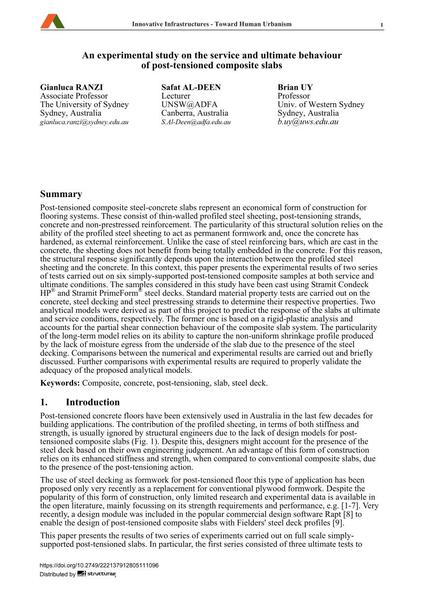An experimental study on the service and ultimate behaviour of post-tensioned composite slabs

|
|
|||||||||||
Détails bibliographiques
| Auteur(s): |
Gianluca Ranzi
Safat Al-deen Brian Uy |
||||
|---|---|---|---|---|---|
| Médium: | papier de conférence | ||||
| Langue(s): | anglais | ||||
| Conférence: | 18th IABSE Congress: Innovative Infrastructures – Towards Human Urbanism, Seoul, Korea, 19-21 September 2012 | ||||
| Publié dans: | IABSE Congress Seoul 2012 | ||||
|
|||||
| Page(s): | 701-708 | ||||
| Nombre total de pages (du PDF): | 8 | ||||
| DOI: | 10.2749/222137912805111096 | ||||
| Abstrait: |
Post-tensioned composite steel-concrete slabs represent an economical form of construction for flooring systems. These consist of thin-walled profiled steel sheeting, post-tensioning strands, concrete and non-prestressed reinforcement. The particularity of this structural solution relies on the ability of the profiled steel sheeting to act as permanent formwork and, once the concrete has hardened, as external reinforcement. Unlike the case of steel reinforcing bars, which are cast in the concrete, the sheeting does not benefit from being totally embedded in the concrete. For this reason, the structural response significantly depends upon the interaction between the profiled steel sheeting and the concrete. In this context, this paper presents the experimental results of two series of tests carried out on six simply-supported post-tensioned composite samples at both service and ultimate conditions. The samples considered in this study have been cast using Stramit Condeck HP® and Stramit PrimeForm® steel decks. Standard material property tests are carried out on the concrete, steel decking and steel prestressing strands to determine their respective properties. Two analytical models were derived as part of this project to predict the response of the slabs at ultimate and service conditions, respectively. The former one is based on a rigid-plastic analysis and accounts for the partial shear connection behaviour of the composite slab system. The particularity of the long-term model relies on its ability to capture the non-uniform shrinkage profile produced by the lack of moisture egress from the underside of the slab due to the presence of the steel decking. Comparisons between the numerical and experimental results are carried out and briefly discussed. Further comparisons with experimental results are required to properly validate the adequacy of the proposed analytical models. |
||||
| Mots-clé: |
béton
|
||||
